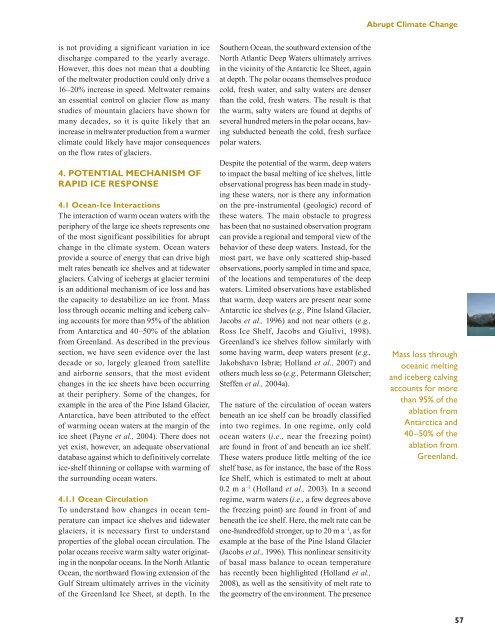Book 2.indb - US Climate Change Science Program
Book 2.indb - US Climate Change Science Program
Book 2.indb - US Climate Change Science Program
- No tags were found...
Create successful ePaper yourself
Turn your PDF publications into a flip-book with our unique Google optimized e-Paper software.
Abrupt <strong>Climate</strong> <strong>Change</strong>is not providing a significant variation in icedischarge compared to the yearly average.However, this does not mean that a doublingof the meltwater production could only drive a16–20% increase in speed. Meltwater remainsan essential control on glacier flow as manystudies of mountain glaciers have shown formany decades, so it is quite likely that anincrease in meltwater production from a warmerclimate could likely have major consequenceson the flow rates of glaciers.4. Potential Mechanism ofRapid Ice Response4.1 Ocean-Ice InteractionsThe interaction of warm ocean waters with theperiphery of the large ice sheets represents oneof the most significant possibilities for abruptchange in the climate system. Ocean watersprovide a source of energy that can drive highmelt rates beneath ice shelves and at tidewaterglaciers. Calving of icebergs at glacier terminiis an additional mechanism of ice loss and hasthe capacity to destabilize an ice front. Massloss through oceanic melting and iceberg calvingaccounts for more than 95% of the ablationfrom Antarctica and 40–50% of the ablationfrom Greenland. As described in the previoussection, we have seen evidence over the lastdecade or so, largely gleaned from satelliteand airborne sensors, that the most evidentchanges in the ice sheets have been occurringat their periphery. Some of the changes, forexample in the area of the Pine Island Glacier,Antarctica, have been attributed to the effectof warming ocean waters at the margin of theice sheet (Payne et al., 2004). There does notyet exist, however, an adequate observationaldatabase against which to definitively correlateice-shelf thinning or collapse with warming ofthe surrounding ocean waters.4.1.1 Ocean CirculationTo understand how changes in ocean temperaturecan impact ice shelves and tidewaterglaciers, it is necessary first to understandproperties of the global ocean circulation. Thepolar oceans receive warm salty water originatingin the nonpolar oceans. In the North AtlanticOcean, the northward flowing extension of theGulf Stream ultimately arrives in the vicinityof the Greenland Ice Sheet, at depth. In theSouthern Ocean, the southward extension of theNorth Atlantic Deep Waters ultimately arrivesin the vicinity of the Antarctic Ice Sheet, againat depth. The polar oceans themselves producecold, fresh water, and salty waters are denserthan the cold, fresh waters. The result is thatthe warm, salty waters are found at depths ofseveral hundred meters in the polar oceans, havingsubducted beneath the cold, fresh surfacepolar waters.Despite the potential of the warm, deep watersto impact the basal melting of ice shelves, littleobservational progress has been made in studyingthese waters, nor is there any informationon the pre-instrumental (geologic) record ofthese waters. The main obstacle to progresshas been that no sustained observation programcan provide a regional and temporal view of thebehavior of these deep waters. Instead, for themost part, we have only scattered ship-basedobservations, poorly sampled in time and space,of the locations and temperatures of the deepwaters. Limited observations have establishedthat warm, deep waters are present near someAntarctic ice shelves (e.g., Pine Island Glacier,Jacobs et al., 1996) and not near others (e.g.,Ross Ice Shelf, Jacobs and Giulivi, 1998).Greenland’s ice shelves follow similarly withsome having warm, deep waters present (e.g.,Jakobshavn Isbræ; Holland et al., 2007) andothers much less so (e.g., Petermann Gletscher;Steffen et al., 2004a).The nature of the circulation of ocean watersbeneath an ice shelf can be broadly classifiedinto two regimes. In one regime, only coldocean waters (i.e., near the freezing point)are found in front of and beneath an ice shelf.These waters produce little melting of the iceshelf base, as for instance, the base of the RossIce Shelf, which is estimated to melt at about0.2 m a –1 (Holland et al., 2003). In a secondregime, warm waters (i.e., a few degrees abovethe freezing point) are found in front of andbeneath the ice shelf. Here, the melt rate can beone-hundredfold stronger, up to 20 m a –1 , as forexample at the base of the Pine Island Glacier(Jacobs et al., 1996). This nonlinear sensitivityof basal mass balance to ocean temperaturehas recently been highlighted (Holland et al.,2008), as well as the sensitivity of melt rate tothe geometry of the environment. The presenceMass loss throughoceanic meltingand iceberg calvingaccounts for morethan 95% of theablation fromAntarctica and40–50% of theablation fromGreenland.57






